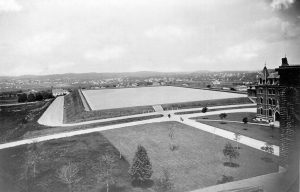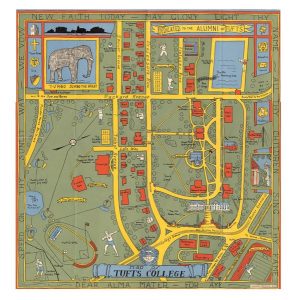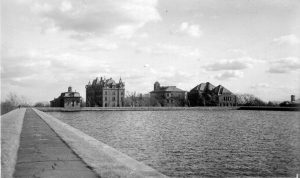By Steven Gentry
Digital Collections and Archives (DCA) unveiled our newest exhibit this fall: “Tufts Traditions: Then and Now.” Found in the two glass cases near the Tower Café, “Tufts Traditions: Then and Now” highlights some of the many traditions practiced by Tufts students over the years—from the “Baby Parties” of Jackson College to the Illumination Ceremony that today’s Tufts seniors experience the night before they graduate.
Tufts traditions are numerous and we found it impossible to highlight more than a fraction of the historical and modern traditions practiced by Tufts students. This blog post will expand on “Tufts Traditions: Then and Now” by discussing a Tufts architectural feature that, while no longer physically present on the Tufts Medford campus, continues to impact contemporary Tufts students: the Mystic Reservoir or, “The Rez.”[i]
 Folsom, A.H. View of "the Rez," ca. 1910. UA136.002.DO.02868. Tufts University. Digital Collections and Archives. Medford, MA. http://hdl.handle.net/10427/402 (accessed September 30, 2016).
Folsom, A.H. View of "the Rez," ca. 1910. UA136.002.DO.02868. Tufts University. Digital Collections and Archives. Medford, MA. http://hdl.handle.net/10427/402 (accessed September 30, 2016).Built on the Hill in 1864 by the city of Charlestown, this reservoir provided water to Charlestown, Somerville, Chelsea, and Tufts College itself.[ii] Although Tufts College would not buy the Rez until shortly before its destruction, the Rez featured prominently in many Tufts traditions.[iii] These traditions included:
- Lighting bonfires, especially to celebrate Tufts’ athletic achievement over its rivals. As noted by Professor Edwin Rollins, “when Tufts won the annual football game from Bowdoin [in 1897] by a score of 20 to 8…[a] billboard was transferred to the hilltop where it made a marvelous blaze.”[iv] The Tufts Weekly reported that students lit a bonfire on the Rez after the Tufts baseball team defeated Harvard in April, 1898.[v]
- Standing on the Rez, especially, the “top of the stairs [of the Rez] near the West Hall pump house,” and proposing a date to another person.[vi] Students did not choose the Rez solely for the view: tradition held that “dates made on the Rez could never be broken.”[vii]
- Musical performances, such as “glee club recitals...[Spring performances] by the Tufts band and orchestra …[and] the annual college sings [that] were held on the banks of the Rez.”[viii] During these college sings “the entire college community would gather there and enjoy the cool breezes across the water, while listening to the various groups competing for the all-college championship.”[ix]
- The banning of first year Tufts students from approaching the Rez. According to Tufts legend, this ban began after a brawl between a Tufts senior and first year resulted in the former being tossed into the Rez.[x]
- Swimming and skating on the Rez, with the former seen as a rite of passage for Tufts students.[xi] However, such activities had their costs: two students were fined $10 in 1942 for illegally being on/in the Rez.[xii]
- Walking around the Rez and enjoying the scenery on quiet Sunday afternoons.[xiii] These ambles served as a way for students to chat with friends, faculty…or even potential love interests.[xiv]
 Blanchard Printing Co. Map of Tufts College. 1930-1940. UA021.002.028.00003. Tufts University. Digital Collections and Archives. Medford, MA. http://hdl.handle.net/10427/57096 (accessed September 30, 2016).
Blanchard Printing Co. Map of Tufts College. 1930-1940. UA021.002.028.00003. Tufts University. Digital Collections and Archives. Medford, MA. http://hdl.handle.net/10427/57096 (accessed September 30, 2016).Not all traditions on the Rez were pleasant or mild. Since 1895, the Rez had the dubious honor as the setting for various drowning incidents.[xv] In 1949, June Livingstone reported on one of the more famous “cases” where a Tufts student—“Lonesome Laura”—drowned herself in the Rez after her husband broke her heart (both Livingstone, as well as the author of the original 1922 Tufts Weekly article, doubted Laura’s existence).[xvi] Additionally, numerous local papers noted that three children drowned in the Rez during the first half of the twentieth century, with William Blanker (of the Boston Globe) noting the Rez’s draining and emptying in 1944 because “three small children had drowned in it within recent years).[xvii] Perhaps inspired by the Rez’s history one Tufts alum recalled that fellow students would sneak to the Rez and lay out clothes of an unknown “victim”—an action that would prompt local police to search the Rez.[xviii]
Although a major landmark for Tufts students, Tufts College completely dismantled the Rez by 1948.[xix] It seems the rarely-utilized reservoir had become a “gaping, trash-littered and dangerous hole [that] should be filled in.”[xx] Although gone, the Rez is not forgotten—today’s Tufts students can live in the Residential Quad or enjoy a cup of coffee from “the Rez.”[xxi] For older alumni, however, a major part of Tufts vanished with the Rez’s deconstruction.[xxii] Consider this (truncated) article, published in an issue of The Tufts Weekly:
“In these long days of Indian Summer, when the warm sun bathes the campus in its amber rays, my thoughts drift back to the days of yesteryear. And the Rez. One could stand on the far side of the old Rez and see the noble outline of West Hall across its limpid waters. But you students of today only see a big expanse of dirt where the speckled trout lept [sic]…You students of today see the broad expanse of dirt where the blue of sky was reflected in the water…In the autumn warmth you students only see the broad expense [sic] of dirt…”[xxiii]
 Rollins, Edwin B. View of campus from The Rez. MS054.003.DO.00980. Tufts University. Digital Collections and Archives. Medford, MA. http://hdl.handle.net/10427/1941 (accessed September 30, 2016).
Rollins, Edwin B. View of campus from The Rez. MS054.003.DO.00980. Tufts University. Digital Collections and Archives. Medford, MA. http://hdl.handle.net/10427/1941 (accessed September 30, 2016).
[i] Sources differ on the official name of this reservoir: it’s been alternatively called “The Mystic Water Works Reservoir” (e.g. Russell Miller, in his Light on the Hill) or the “Mystic Reservoir” (e.g. in William Blanker’s “Medford’s Mystic Reservoir, Historic Landmark, is Gone,” published in the October 14, 1948 issue of the Boston Globe).
[ii] Russell Miller, Light on the Hill: A History of Tufts College 1852-1952 (Boston: Beacon Press, 1966), 65; Facilities Management records, 1849-2004, Reservoir 1875-1967, UA021.001.015.00001, Tufts University, Digital Collections and Archives, Medford, MA; see also Traditions at Tufts, Traditions at Tufts 1959, UP153.001.001.00001, Tufts University, Digital Collections and Archives, Medford, MA.
[iii] Reservoir, 1865-1944, Concise Encyclopedia of Tufts History, http://dl.tufts.edu/catalog/tei/tufts:UA069.005.DO.00001/chapter/R00003; Facilities Management records, Buildings and Grounds, Letter to Arthur Pierce dated 1923-12-05, UA021.001.015.00001, Tufts University, Digital Collections and Archives, Medford, MA.
[iv] Edwin B. Rollins papers, Notebooks, Through the years at Tufts 1940-1955, MS054.001.002.00004, Tufts University, Digital Collections and Archives, Medford, MA. See also: “A Decisive Victory: Bowdoin Defeated by a Score of 20 – 8,” Tufts Weekly, vol. 3 (1897): 1, see also 2 (“The Celebration”), UP056.001.001.00073, Tufts University, Digital Collections and Archives, Medford, MA.
[v] Edwin B. Rollins papers, Notebooks, Through the years at Tufts 1940-1955, MS054.001.002.00004, Tufts University, Digital Collections and Archives, Medford, MA. See also Tufts Weekly, “Harvard Yields to Tufts,” vol. 3 (1898): 1, see also page 2 (“The Celebration”), UP056.001.001.00090, Tufts University, Digital Collections and Archives, Medford, MA.
[vi] Facilities Management records, Buildings and Grounds, J.L. Wagman Essay on the Rez, UA021.001.015.00001 Tufts University, Digital Collections and Archives, Medford, MA.
[vii] Reservoir, 1865-1944, Concise Encyclopedia of Tufts History, http://dl.tufts.edu/catalog/tei/tufts:UA069.005.DO.00001/chapter/R00003; Facilities Management records, Buildings and Grounds, Reservoir 1875-1967, UA021.001.015.00001.
[viii] Facilities Management records, Buildings and Grounds, “Medford’s Mystic Reservoir, Historic Landmark, is Gone,” UA021.001.015.00001, Tufts University, Digital Collections and Archives, Medford, MA. For additional information, see other items in this folder: Facilities Management records, Buildings and Grounds, Reservoir 1875-1967, UA021.001.015.00001.
[ix] Ibid.
[x] Reservoir, 1865-1944, Concise Encyclopedia of Tufts History, http://dl.tufts.edu/catalog/tei/tufts:UA069.005.DO.00001/chapter/R00003; Facilities Management records, Buildings and Grounds, “Medford’s Mystic Reservoir, Historic Landmark, is Gone,” UA021.001.015.00001.
[xi] Facilities Management records, Buildings and Grounds, “Medford’s Mystic Reservoir, Historic Landmark, is Gone,” UA021.001.015.00001.
[xii] Ibid.
[xiii] Ibid.
[xiv] Ibid.; Reservoir, 1865-1944, Concise Encyclopedia of Tufts History, http://dl.tufts.edu/catalog/tei/tufts:UA069.005.DO.00001/chapter/R00003; see also Facilities Management records, Buildings and Grounds, Reservoir 1875-1967, UA021.001.015.00001; see also Traditions at Tufts, Traditions at Tufts 1959, UP153.001.001.00001.
[xv] Facilities Management records, Buildings and Grounds, J.L. Wagman Essay on the Rez, UA021.001.015.00001 Tufts University, Digital Collections and Archives, Medford, MA.
[xvi] Livingstone, June, “Reservoir Mystery Was Never Solved.” Tufts Weekly, vol. 54 (1949): 3, 7, UP056.001.043.00002, Digital Collections and Archives, Medford, MA; “Was There—Wasn’t There? Or Who Dropped the Note?: Sherlocks Encounter Problem in Green Depths of Rez,” Tufts Weekly, vol. 21 (1922): 1, UP056.001.014.00004, Tufts Digital Library, Digital Collections and Archives, Medford, MA.
[xvii] Reservoir, 1865-1944, Concise Encyclopedia of Tufts History, http://dl.tufts.edu/catalog/tei/tufts:UA069.005.DO.00001/chapter/R00003; Facilities Management records, Buildings and Grounds (including William Blanker’s “Medford’s Mystic Reservoir, Historic Landmark, is Gone,”), UA021.001.015.00001, Tufts University, Digital Collections and Archives, Medford, MA.
[xviii] Facilities Management records, Buildings and Grounds, J.L. Wagman Essay on the Rez, UA021.001.015.00001, Tufts University, Digital Collections and Archives, Medford, MA; see also Traditions at Tufts, Traditions at Tufts 1959, UP153.001.001.00001.
[xix] Sources often note how Tufts bought the Rez for $1.00 in 1944 (e.g. “The First 150 Years,” Tufts Magazine, Spring 2002, 41).
[xx] Reservoir, 1865-1944, Concise Encyclopedia of Tufts History, http://dl.tufts.edu/catalog/tei/tufts:UA069.005.DO.00001/chapter/R00003; Facilities Management records, Buildings and Grounds, “Medford’s Mystic Reservoir, Historic Landmark, is Gone,” UA021.001.015.00001.
[xxi] Ibid.
[xxii] Ibid.
[xxiii] Tufts Weekly, November. 9, 1950 (page 3), UP056.001.044.00008, Tufts University. Digital Collections and Archives. Medford, MA.







